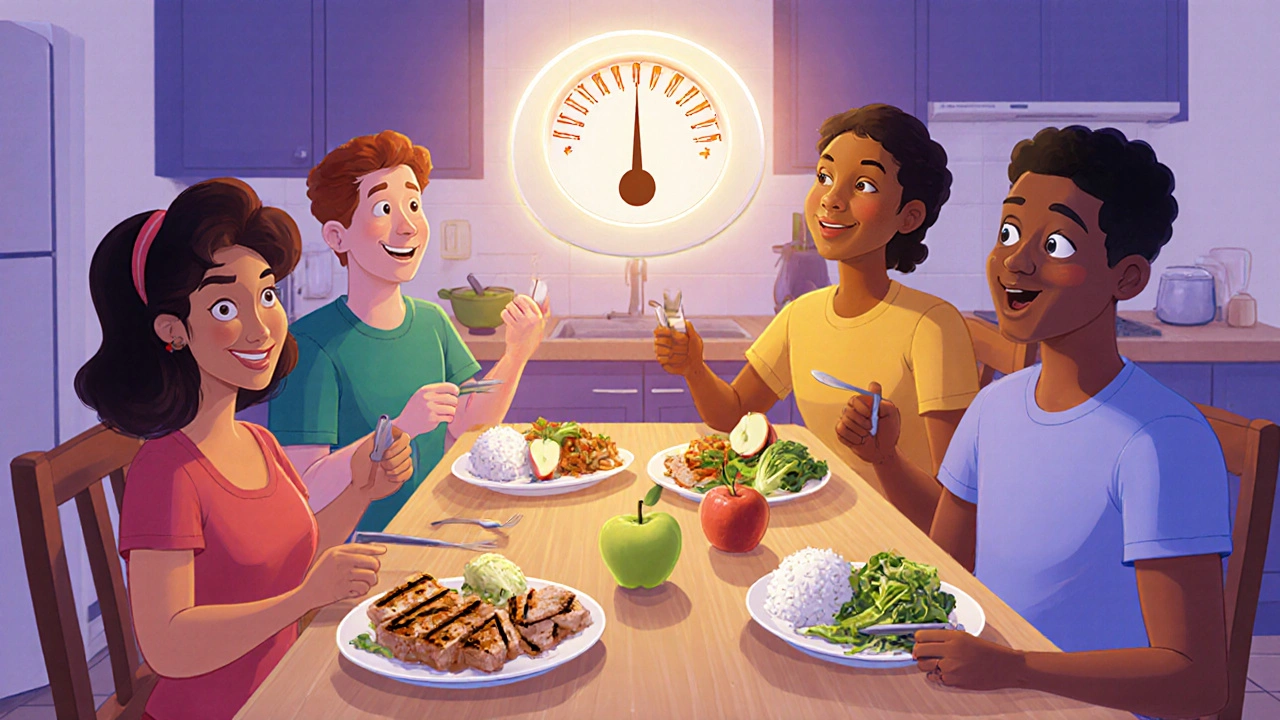When your kidneys aren’t working well, what you eat matters more than you might think. For people with chronic kidney disease (CKD), protein isn’t just about building muscle or feeling full-it’s a balancing act that can slow damage, delay dialysis, or even help you live longer. But how much is too much? Too little? And does it matter if it comes from chicken or lentils? The answers aren’t one-size-fits-all. They change depending on how far your kidney function has declined.
What Protein Does (and Doesn’t Do) in Kidney Disease
Your kidneys filter waste from your blood. When you eat protein, your body breaks it down into nitrogen-based waste called urea. Healthy kidneys handle this easily. But when kidney function drops, urea builds up, making you feel tired, nauseous, or just generally unwell. Reducing protein intake lowers this waste load, which is why doctors have recommended protein restriction since the 1920s.
But here’s the catch: protein also keeps your muscles strong, supports your immune system, and helps you heal. Too little protein can lead to muscle wasting-a serious problem in CKD. Studies show 30-50% of people with stage 3-5 CKD develop protein-energy wasting. That’s not just weakness; it’s linked to higher death rates. So the goal isn’t to cut protein to the bone. It’s to find the sweet spot: enough to stay strong, but not so much that your kidneys are overwhelmed.
Protein Targets by CKD Stage
Protein needs shift as kidney function declines. The Kidney Disease Outcomes Quality Initiative (KDOQI) and the National Kidney Foundation’s 2023 guidelines give clear ranges based on your estimated glomerular filtration rate (eGFR).
- CKD Stage 1-2 (eGFR ≥60): Aim for 0.8 grams of protein per kilogram of ideal body weight daily. For someone who weighs 150 pounds (68 kg), that’s about 54 grams. This isn’t a strict limit-it’s a ceiling. Most people eat more than this anyway. The key is avoiding high-protein diets over 1.3 g/kg/day, which may speed up kidney damage.
- CKD Stage 3a-3b (eGFR 45-59): Start moving toward 0.6-0.8 g/kg/day. If you’re losing muscle or struggling to eat enough, your dietitian might keep you at the higher end.
- CKD Stage 4 (eGFR 15-29): Target 0.55-0.60 g/kg/day. For a 150-pound person, that’s 40-54 grams. Half of that protein should come from high-quality sources: eggs, fish, chicken, lean beef, or soy. These have all the essential amino acids your body needs.
- CKD Stage 5 (eGFR <15, not on dialysis): Still 0.55-0.60 g/kg/day. But if you’re on dialysis, your needs jump dramatically-up to 1.2 g/kg/day-because dialysis removes protein too.
There’s debate. A 2024 JAMA Network Open study found that older adults with early-stage CKD who ate more protein (up to 0.8 g/kg) had lower death rates. Why? Because many die from heart disease before their kidneys fail completely. So if you’re over 65, frail, or losing weight, your doctor might recommend keeping protein higher-even if your eGFR is low.

Animal vs. Plant Protein: Which Is Better?
Not all protein is created equal when it comes to kidneys.
Animal proteins-like steak, chicken, and cheese-produce more urea and phosphorus per gram. They also generate advanced glycation end products (AGEs), chemicals that cause inflammation and oxidative stress. One study found red meat creates up to 50% more AGEs than plant proteins.
Plant proteins-beans, lentils, tofu, nuts, and whole grains-generate 20-30% less waste. A 2021 meta-analysis showed replacing just 30% of animal protein with plant protein cut CKD progression risk by 14% and lowered death risk by 11%. That’s huge.
But plant proteins often lack one or two essential amino acids. Soy is the exception-it’s complete. To get all the amino acids you need, mix your plant proteins: rice and beans, hummus and whole wheat pita, peanut butter on oatmeal. You don’t need to eat them in the same meal-just within the same day.
The trade-off? Many plant foods are high in potassium. That’s a problem for stage 4-5 CKD patients who need to limit potassium to avoid dangerous heart rhythms. Sweet potatoes, spinach, and beans are nutritious but risky. A renal dietitian can help you choose lower-potassium plant options like cauliflower, cabbage, or apples.
Special Cases: Diabetes, Older Adults, and Weight Loss
If you have diabetes and CKD, protein targets get trickier. Too little protein can make blood sugar harder to control. The American Diabetes Association recommends 0.8-0.9 g/kg/day for this group. It’s a narrow window-enough to protect your kidneys, but enough to keep your muscles and metabolism stable.
Older adults are another special case. Muscle loss is common with age. A 75-year-old with stage 3 CKD might need more protein than a 45-year-old with the same eGFR. The goal shifts from slowing progression to preserving function and independence.
If you’re losing weight unintentionally, protein restriction may need to be paused. Malnutrition is a bigger immediate threat than slow kidney decline. Your care team will weigh risks: Is your kidney function dropping fast? Are you losing muscle? Are you eating enough calories? The answer isn’t always to eat less protein-it’s to eat smarter.
How to Actually Do This: Real-Life Strategies
Knowing the numbers is one thing. Eating like that every day is another.
Most people struggle. A 2024 survey found 74% of CKD patients on protein restrictions felt constantly hungry. 62% felt weak. 58% avoided social meals because they couldn’t eat what everyone else was having.
Here’s what works:
- Use a protein calculator. The National Kidney Foundation’s app lets you enter your weight and stage, then shows you daily protein targets. It’s free and downloaded over 47,000 times since 2023.
- Track your meals. Apps like MyFitnessPal have renal databases. You can search for low-protein versions of common foods-like white rice instead of brown, or egg whites instead of whole eggs.
- Meal prep. Cook in batches. Make a kidney-friendly stir-fry with tofu, cabbage, and white rice. Portion it out. That way, you’re never stuck guessing at dinner.
- Choose high-quality protein. At every meal, aim for one source: one egg, 2 oz chicken, ½ cup tofu, or 1 oz cheese. Spread it out. Don’t save it all for dinner.
- Work with a renal dietitian. Patients who do this are 3.2 times more likely to stick to their plan. Insurance often covers it-Medicare now pays for 3 hours of initial counseling and 2 hours of follow-up each year.
Some people use keto acid analogues-medications like Ketosteril-that provide essential amino acids without the nitrogen waste. They’re prescribed to about 15% of stage 4-5 patients in Europe. In the U.S., they’re less common but available by prescription.
What’s Next in Renal Nutrition
The field is moving beyond fixed numbers. The NIH-funded PRECISE-CKD trial is testing whether protein targets should be based on your individual urea production-not just your weight. Someone who naturally makes more waste might need less protein than someone who makes less, even if they weigh the same.
Researchers are also developing plant-based protein concentrates with lower potassium. Imagine a soy protein powder that’s safe for stage 4 CKD. That could change everything.
And while protein restriction remains a cornerstone of care, the focus is shifting. It’s not just about how much you eat-it’s about what kind. Quality over quantity. Plant-based over processed. Whole foods over supplements.
92% of nephrologists agree: individualized protein plans will still be essential in 2030. But the future isn’t about rigid rules. It’s about smart, flexible, personalized eating that keeps you alive, strong, and able to enjoy your meals.
How much protein should I eat if I have stage 3 CKD?
For stage 3 CKD (eGFR 45-59), aim for 0.6 to 0.8 grams of protein per kilogram of your ideal body weight daily. For a 150-pound person, that’s about 40-54 grams. If you’re losing muscle, feeling weak, or have diabetes, your dietitian may recommend staying closer to 0.8 g/kg. Avoid going above 1.3 g/kg/day, as higher intake may speed up kidney damage.
Is plant protein better than animal protein for kidney disease?
Yes, in most cases. Plant proteins like beans, lentils, tofu, and nuts produce 20-30% less waste than animal proteins and are linked to slower CKD progression and lower death rates. A 2021 study found replacing 30% of animal protein with plant protein cut CKD progression risk by 14%. But plant proteins often lack full amino acid profiles, so mix them (like rice and beans). Watch potassium levels-some plant foods are high in potassium, which can be dangerous in later stages.
Can I eat meat if I have kidney disease?
Yes, but choose wisely. Lean meats like chicken, turkey, fish, and eggs are better than red meat or processed meats. Red meat produces more waste and harmful compounds called AGEs. Limit red meat to once a week or less. Keep portions small-about the size of a deck of cards (2-3 oz). Pair meat with low-potassium vegetables and white rice or pasta to balance your meal.
Why do I feel weak on a low-protein diet?
You might not be getting enough protein-or enough calories. Many people with CKD feel weak because they cut protein too much without replacing the lost calories. Your body starts breaking down muscle for energy. Make sure you’re eating enough carbs and healthy fats (like olive oil, avocado, and unsalted nuts). Talk to a renal dietitian to adjust your plan so you’re getting enough protein to protect your muscles without overloading your kidneys.
Should I use protein supplements for kidney disease?
Generally, no-unless prescribed. Most protein powders are made from whey or casein, which are high in phosphorus and nitrogen. They can worsen kidney stress. If you’re struggling to meet protein needs, your doctor might prescribe keto acid analogues like Ketosteril, which provide amino acids without the waste. Never take over-the-counter protein supplements without talking to your nephrologist or dietitian.
How often should I see a renal dietitian?
Start with a 60-90 minute initial session. Then, plan for follow-ups every 4-6 weeks, especially when your CKD stage changes or if you’re losing weight. Medicare covers 3 hours of initial counseling and 2 hours of follow-up per year. Many patients see better results with regular check-ins-adherence rates jump from 24% to 78% with structured dietitian support.
If you’re managing CKD, protein isn’t the enemy. It’s a tool. Used right, it can help you stay strong, avoid dialysis longer, and live better. The key is working with your care team to find your personal target-not someone else’s.


1 Comments
Kartik Singhal
Wow, another ‘eat less protein’ lecture from the kidney industrial complex 😒
Meanwhile, Big Nephro is quietly funding studies that make plant protein look ‘safer’ while pushing expensive keto acid analogues that cost more than my rent. Coincidence? I think not. 🤔
My uncle was told to cut protein at stage 3… died of muscle wasting in 8 months. They didn’t tell him about the hidden carbs in ‘kidney-friendly’ rice cakes. 🍚💀
Who profits when you’re too weak to work? Not you. Not your family. Definitely not the dietitian who gets paid per hour. 🤑